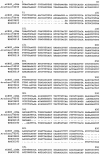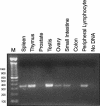Usher syndrome type III: revised genomic structure of the USH3 gene and identification of novel mutations
- PMID: 12145752
- PMCID: PMC449697
- DOI: 10.1086/342098
Usher syndrome type III: revised genomic structure of the USH3 gene and identification of novel mutations
Abstract
Usher syndrome type III is an autosomal recessive disorder characterized by progressive sensorineural hearing loss, vestibular dysfunction, and retinitis pigmentosa. The disease gene was localized to 3q25 and recently was identified by positional cloning. In the present study, we have revised the structure of the USH3 gene, including a new translation start site, 5' untranslated region, and a transcript encoding a 232-amino acid protein. The mature form of the protein is predicted to contain three transmembrane domains and 204 residues. We have found four new disease-causing mutations, including one that appears to be relatively common in the Ashkenazi Jewish population. We have also identified mouse (chromosome 3) and rat (chromosome 2) orthologues, as well as two human paralogues on chromosomes 4 and 10.
Figures






References
Electronic-Database Information
-
- Blast the Mouse Genome, http://www.ncbi.nlm.nih.gov/genome/seq/MmBlast.html (for mouse genome BLAST versus Arachne [Whole Genome Shotgun assembly by the Whitehead Institute])
-
- DNASTAR, http://www.dnastar.com/ (for Lasergene 5.0 software)
-
- Ensembl-Arachne Mouse Contigs, http://www.ensembl.org/Mus_musculus/contigview/ (for contigs 176095 and 334287; query format is contig_######)
-
- GenBank, http://www.ncbi.nlm.nih.gov/Genbank/ (for 207-kb genomic contig sequence [accession number AF388363], BAC clone RP11-251C9 [accession number AC020636], USH3Joensuu cDNA [accession numbers AF388366 and AF388368], putative USH3 paralogue peptide sequences [accession numbers XP_058398 and XP_068256], USH3revised cDNA [accession number AF482697], USH3 (rat) cDNA [accession number AF482698], and assembly of putative USH3 (Mouse) cDNA [accession numbers BB630393, BB638319 and BB639483])
-
- Genome Survey Sequences Database, http://www.ncbi.nlm.nih.gov/dbGSS/
References
-
- Astuto LM, Weston MD, Carney CA, Hoover DM, Cremers CW, Wagenaar M, Moller C, Smith RJ, Pieke-Dahl S, Greenberg J, Ramesar R, Jacobson SG, Ayuso C, Heckenlively JR, Tamayo M, Gorin MB, Reardon W, Kimberling WJ (2000) Genetic heterogeneity of Usher syndrome: analysis of 151 families with Usher type I. Am J Hum Genet 67:1569–1574 - PMC - PubMed
-
- Joensuu T, Blanco G, Pakarinen L, Sistonen P, Kaariainen H, Brown S, Chapelle A, Sankila EM (1996) Refined mapping of the Usher syndrome type III locus on chromosome 3, exclusion of candidate genes, and identification of the putative mouse homologous region. Genomics 38:255–263 - PubMed
-
- Joensuu T, Hamalainen R, Lehesjoki AE, de la Chapelle A, Sankila EM (2000) A sequence-ready map of the Usher syndrome type III critical region on chromosome 3q. Genomics 63:409–416 - PubMed
Publication types
MeSH terms
Substances
Associated data
- Actions
- Actions
- Actions
- Actions
- Actions
- Actions
- Actions
- Actions
- Actions
- Actions
- Actions
- Actions
Grants and funding
LinkOut - more resources
Full Text Sources
Other Literature Sources
Medical
Molecular Biology Databases

